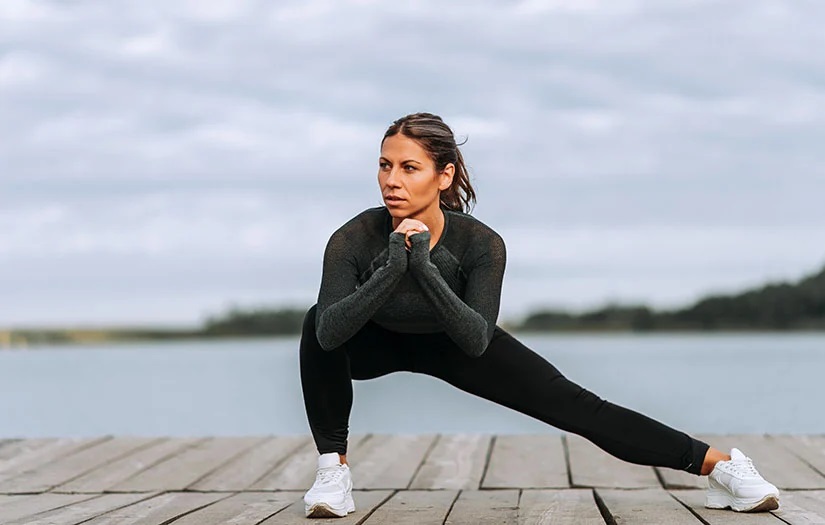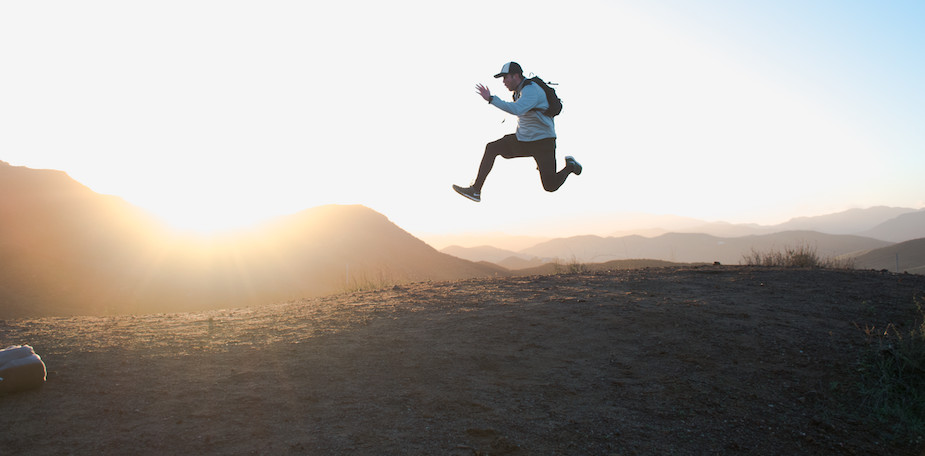You’ve looked up different fitness routines for stronger legs, but every single one includes squats. Maybe you’re feeling a little burned out on squats, or you just want to add some variety to your workout routine.
What leg exercises can you do to get stronger legs without having to do squats? I’m glad you asked. This article will cover 8 leg strengthening exercises that aren’t squats.
Strengthening Legs Without Squats
Squats are a functional movement pattern that we use daily to sit and stand. They’re also effective and efficient when it comes to strengthening the legs since they target the quads, glutes, and groin muscles all in one movement. This explains why so many fitness professionals tout the benefits of performing this well-known leg exercise.
The good news is, there are a variety of ways that you can target these same muscle groups to build strength in the legs. As for building efficiency in the all-important squat movement pattern (to help you sit and stand with ease), movements like leg presses, step-ups, and lunges are good alternatives to perform. Check out these squat alternatives for some quality leg strengthening without having to squat:
8 Squat Alternatives
#1 Machine Leg Press for Quads, Glutes, and Groin
Double Leg Press
• Place feet hip to shoulder width apart on the machine, feet facing straight ahead. Find a foot placement that allows you to bend the knees comfortably.
• Make sure the back is flat, the shoulders are down, and keep your core tight as you bend the knees.
• Bend the knees as far as you can without losing neutral spine or letting the thighs touch the chest.
• Press evenly through both feet (pressing through the mid-foot) to return to the starting position, and repeat.
• Be sure to check machine instructions for how to lock and unlock the foot platform to avoid injury.
Single Leg Press
• Perform the exercise the same way as the double leg press but remove one foot from the platform during the exercise.
#2 Step ups for Quads, Glutes, and Groin
Step Ups
• Stand with good posture, facing the box. Start with a low box height and gradually increase the height as you get stronger and more stable.
• Step one foot firmly on top of the box, shift your weight slightly forward, and push off the mid-foot of the stepping foot to step up on top of the box.
• Stand tall and squeeze the glutes at the top, raising the opposite knee for an extra balance challenge.
• Slowly return to the starting position. You can complete all reps on the same side before switching, or alternate legs.
Side Step Ups
• This is the same as the step-ups but facing sideways (which makes the balance a bit more challenging!).
• Step with the leg closest to the step and keep those toes pointing straight ahead for optimal alignment.
#3 Lunges for Quads, Glutes, and Groin
Reverse Lunges
• Stand tall with good posture, abs engaged, and with feet hip width apart.
• Step one foot back into the lunge, while keeping the weight in the front leg.
• Push through the mid-foot of the front leg to come to a tall, standing position, and squeeze the glutes at the top of the movement.
• Stay on the same leg to complete all reps before switching legs, or alternate legs.
Lateral Lunges
• This is a progression of the lunge!
• Stand tall with good posture, abs engaged, and with feet hip width apart.
• Step one foot laterally into the lunge, sitting the hips back as you lunge. Take a big enough step so that the trailing leg is straight, and the lunging leg is bent with the hip, knee, and ankle stacked on top of one another when you look at them straight-on.
• Push through the mid-foot of the lunging leg to return to a tall, standing position, and squeeze the glutes at the top of the movement.
• Stay on the same leg to complete all reps, or alternate legs.
#4 Bulgarian Split Squat for Quads, Glutes, and Groin
Bulgarian Split Squat
• To find your starting position, stand with your calves touching the bench, and take a step forward just shy of where you would be for a forward lunge.
• Prop your back foot on the bench to rest there and shift your weight forward.
• Keep your shoulders down and abs tight as you drop into the split squat, allowing the back knee to travel back as needed to keep that knee in line with your hip back.
• Drive through the mid-foot of the front leg and squeeze the glutes to return to the starting position.
• Repeat to finish all reps on the same side before switching.
#5 Floor Bridge for Glutes and Core
Floor Bridge
• Lay on your back with your arms at your sides with the palms up, and knees bent so that your feet are about 6 inches away from your glutes. Drop the shoulders down, and pull the abs in.
• Squeeze the glutes and press through the mid foot to raise the hips off of the ground. Keep the hips tucked under as you lift as high as you can, aiming to get the hips in line with the knees and shoulders. Squeeze the glutes tight as you get to the top.
• Slowly lower down until you’re barely touching the mat, and immediately lift back up into the next rep.
• Hold a dumbbell or sandbag across the hips to add resistance for strengthening.
#6 Deadlift for Glutes and Hamstrings
Kettlebell Deadlift
Barbell Deadlift
• This move can be performed with either a kettlebell or with a barbell, as shown in the video exercise library.
• For the kettlebell, start with the weight between the feet. For the barbell, step up to the bar so that the bar is over your shoelaces.
• Grasp your weight and set the shoulders by pulling the shoulders down and back, which will cause you to create a little tension as you pull on your barbell or kettlebell without lifting it off the ground.
• Brace your abs and drive through the mid-foot to press the weight off the floor.
• Squeeze the glutes as you stand tall, avoiding leaning back at the top of the move.
• Keep your shoulders set and core braced as you hinge at the hips and bend the knees to return to the starting position.
• Reset, and repeat.
#7 RDL for Glutes and Hamstrings
Dumbbell Romanian Deadlift
Romanian Deadlift Barbell
The main difference between an RDL and a Deadlift is the fact that the knees are only softly bent in an RDL, focusing more on the hamstrings.
• Stand tall, with shoulders down and back and abs tight, while holding your weight in front of you.
• Hinge at the hips and slightly bend at the knees, keeping the weight close to your legs. Keep your neck in a neutral position (i.e., don’t look straight ahead at yourself in the mirror during the move. This will cause extension in the cervical spine).
• Your hips will shift back during the hinge, like you’re trying to touch the wall behind you with your glutes.
• Hinge as far as your hips will let you go without rounding your back forward.
• Squeeze the glutes as you return to the starting position.
#8 Leg curls for Hamstrings
Lying Leg Curl
• Lay face down at the machine, adjusting the settings to make sure that the bar is at the lower calf/Achilles and the knee is close to the hinge.
• Keep the core tight, the shoulders down, and your head in line with your spine during the movement.
• Pull your toes toward your knees and bend the legs as far as you can go without arching your back.
• Control the movement back to the start position and repeat.
Seated Leg Curl
• Set up the machine so that your knee is close to the hinge, and the bar is at the lower calf/Achilles. Sit with your feet hip width apart.
• Keep your abs tight and bend the knees as far as you can without arching your lower back.
• Control the movement to return to the starting position.
Which Squat Alternatives Should You do for A Bad Back?
The best exercises to try if you have back issues are the machine leg press, step-ups (start lower), floor bridge (these can be done on a bench or elevated surface if you can’t get to the ground), and leg curls. Start with a lightweight or bodyweight to see if the movement feels good for you.
Which Squat Substitutes Should You do for Bad Knees?
If your knees tend to bother you, machine leg presses, step-ups (start low), floor bridges, RDLs, and leg curls are great alternatives to strengthen the legs without putting much stress on the knees.
Can You Get the Fastest Results By Squatting? Or Will Alternatives Get You There Just as Quick?
When focusing on lower-body strength, the quads, glutes, hamstrings, and groin are all important muscle groups to target. Just like there’s no “best exercise” for losing weight, there’s also no single “best exercise” for building leg strength. Because many of these squat alternatives target the quads, glutes, and groin just like the squat, they can also be equally effective in building leg strength.
The key point here is: You can strengthen the legs efficiently, even without squats! You don’t have to continually do sets of Kettlebell Goblet Squats to see the results you want!



